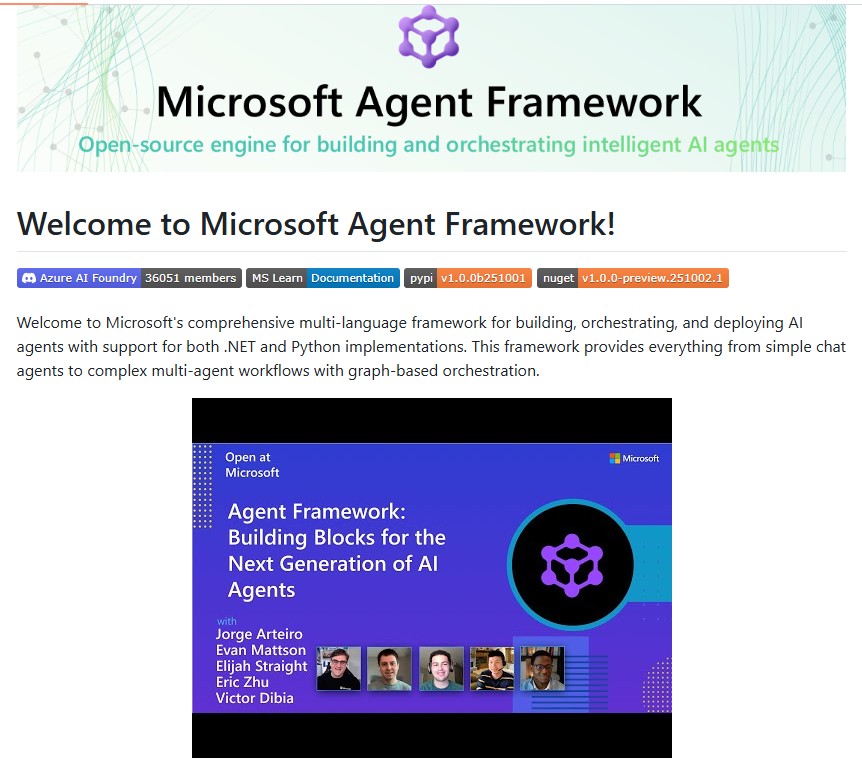Artificial Intelligence has rapidly moved beyond simple chatbots to complex multi-agent systems that can collaborate, reason and solve real-world problems. To enable developers and enterprises to harness the full potential of AI agents, Microsoft has introduced the Agent Framework – a comprehensive, open-source toolkit designed for building, orchestrating and deploying AI-powered agents and workflows.

In this blog, we will explore what the Microsoft Agent Framework is, its key features, use cases and why it could be a game-changer for anyone working with AI agents, large language models (LLMs) and multi-agent orchestration.
What is Microsoft Agent Framework?
The Microsoft Agent Framework is a multi-language, production-ready framework for creating and managing AI agents. It supports both Python and .NET, providing a consistent set of APIs and tools across languages.
From a simple AI assistant that generates creative text to sophisticated multi-agent workflows that connect multiple models and tools, the framework gives developers everything they need to scale AI development.
Available on GitHub (microsoft/agent-framework), it is fully open-source under the MIT license.
Key Features
The framework is designed with scalability, flexibility and enterprise-readiness in mind. Here are some of its standout features:
1. Graph-based Workflows
Create multi-agent workflows using graph-based orchestration. Developers can connect agents, deterministic functions and external tools into complex pipelines with support for:
- Streaming results in real-time
- Checkpointing for workflow recovery
- Human-in-the-loop validation
- Time-travel capabilities for debugging and auditing
2. Cross-language Support: Python and .NET
The framework offers consistent APIs across both Python and .NET. Whether you’re building in C# for enterprise systems or Python for data science workflows, you can rely on the same underlying architecture.
3. DevUI for Interactive Development
The DevUI allows developers to visually design, test, and debug AI agents and workflows. This is particularly useful for teams working on complex orchestration patterns, making development faster and more intuitive.
4. Built-in Observability with OpenTelemetry
Monitoring and debugging distributed AI systems is often challenging. The Microsoft Agent Framework includes OpenTelemetry integration for tracing, metrics and logs, ensuring transparency and reliability in production.
5. Multi-Provider LLM Support
The framework supports various large language model providers including Azure OpenAI, with more integrations continuously added. This flexibility allows teams to switch providers or use multiple models within a single workflow.
6. Middleware for Custom Pipelines
Developers can extend functionality using the middleware system, customizing request/response processing, exception handling and data pipelines.
7. Migration Support from Other Frameworks
For teams already using Semantic Kernel or AutoGen, Microsoft provides clear migration guides, making it easier to transition to the Agent Framework without losing existing investments.
Installation and Quick Start
Python Installation
pip install agent-framework --pre
.NET Installation
dotnet add package Microsoft.Agents.AI
Once installed, you can create a simple AI agent in just a few lines of code.
Python Example:
from agent_framework.azure import AzureOpenAIResponsesClient
from azure.identity import AzureCliCredential
agent = AzureOpenAIResponsesClient(credential=AzureCliCredential()).create_agent(
name="HaikuBot",
instructions="You are an upbeat assistant that writes beautifully."
)
print(await agent.run("Write a haiku about Microsoft Agent Framework."))
.NET Example:
using Microsoft.Agents.AI;
using Azure.AI.OpenAI;
using Azure.Identity;
var agent = new AzureOpenAIClient(new Uri(endpoint), new AzureCliCredential())
.GetOpenAIResponseClient(deploymentName)
.CreateAIAgent(name: "HaikuBot", instructions: "You are an upbeat assistant that writes beautifully.");
Console.WriteLine(await agent.RunAsync("Write a haiku about Microsoft Agent Framework."));
Use Cases of Microsoft Agent Framework
The flexibility of the framework allows it to be applied in multiple scenarios:
- Conversational AI: Build advanced chatbots with contextual reasoning.
- Enterprise Workflows: Orchestrate AI across departments for customer support, HR automation, and IT operations.
- Multi-Agent Research: Experiment with multi-agent collaboration, reinforcement learning and decision-making.
- AI-Powered Applications: Embed intelligent agents directly into software products built with Python or .NET.
- Monitoring and Observability: Deploy agents with built-in metrics, ensuring compliance and reliability.
Why Choose Microsoft Agent Framework?
- Enterprise-Ready: Designed for organizations running on Azure and .NET ecosystems.
- Open Source: MIT-licensed and community-driven, with active development and contributions.
- Future-Proof: Regular updates, experimental labs (AF Labs) and ongoing research support.
- Developer-Friendly: Rich documentation, samples and a growing ecosystem of tools.
Conclusion
The Microsoft Agent Framework marks a significant step forward in the evolution of AI agents. With its ability to support both Python and .NET, robust orchestration features and enterprise-ready observability, it provides a solid foundation for building the next generation of AI-powered applications.
Whether you are a researcher, developer, or enterprise architect, this framework enables you to go beyond basic chatbot functionality and unlock the full potential of multi-agent workflows.
Start exploring today: Microsoft Agent Framework on GitHub
Related Reads
SkyPilot: Simplifying AI Workload Management Across Any Infrastructure
Motia: The Unified Backend Framework That Eliminates Runtime Fragmentation
LLaMA-Factory: Simplifying Fine-Tuning for 100+ Large Language and Vision Models
RAGFlow: Revolutionizing AI with Retrieval-Augmented Generation

3 thoughts on “Powerful Microsoft Agent Framework: Build, Orchestrate and Deploy AI Agents with Python and .NET”